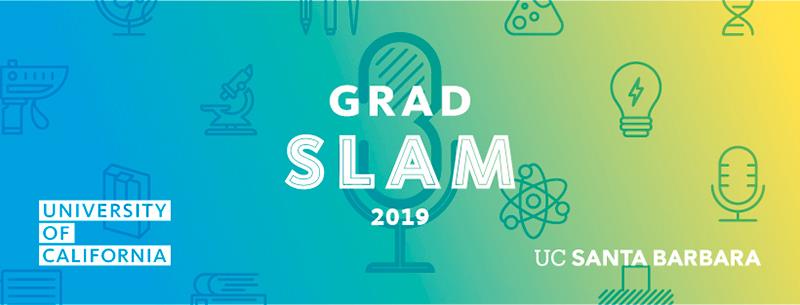Top Stories
Join us as we wrap up the second stage of the 7th Annual Grad Slam with our last semifinal round! Three students from each semifinal round will advance to the final round happening later this week. Check out a preview of the presentations here and be sure to follow on Facebook for live updates on the winners of each round.

Join us as we âwrap up the second stage of the 7th Annual Grad Slam with our last semifinal round! âThree students from each semifinal round will advance to the final roundâ happening later this week. Check out a preview of the presentations below and be sure to follow on Facebook for live updates on the winners of each round.
SEMIFINAL ROUND 3
Wed Apr 17 | 11a-12p
SRB Multipurpose Room
David Mun | âEnvironmental Science & Management
The Apparel Industry: Reducing Environmental and Social Impact through Materials Innovation
Apparel companies are hungry for sustainable and closed-loop materials. My research focuses on utilizing agricultural cannabis waste to make the material that goes into making the clothing we wear everyday. This innovation will help reduce the amount of chemicals that workers are exposed to as well as reduce the intense land and water use that plagues the apparel supply chain today.
Geneva Alok | ââMolecular, Cellular & Developmental Biology
It Started out with Mitosis. How Did it End up Like This?
In development, a single cell divides and eventually becomes an entire organism. My project seeks to understand the flexibility of gene regulatory networks that govern this process by using the C. elegans endoderm as a model.
Kathryn Harrison | Communication
Sharing a (Cyber)Space: Fostering Relationship Maintenance and a Sense of Community in an Assisted Living Community Through Virtual Reality
For most residents of an assisted living community (ALC), the loss of social network ties could damage their access to social support and essential resources, as well as social engagement and attachments. The central focus of this study was to further understand the positive implications of virtual reality on social isolation and engagement in an ALC. It is possible that interacting with one another through VR in an ALC could improve quality of life, closeness, and sense of community. This in turn could allow residents to form and maintain deeper connections to one another and thrive in a potentially stressful and lonely stage of life.
Khanh Nguyen | Chemistry
When Proteins Hold Hands and Dance
Therapeutic drugs take effects on the human body via proteins, biological molecules that may just be a few millionths of an inch in size. The drug acts like a key to unlock and interact with the protein. Making an actual key in real life requires one to see the inside of the lock, just like designing drugs requires one to see the detailed structure of proteins. How do scientists look at something so tiny in such high-resolution details to cure diseases?
Nicole Zamanzadeh | âCommunication
Media Multitasking and Teen Stress: Developmental And Parental Risk Factors
Today's society is increasingly saturated by and reliant upon portable smart devices, which facilitate constant and simultaneous access to multiple media. This study examined adolescents' vulnerability to unhealthy media habits. Parent-adolescent dyads (N=250) participated in a one-week longitudinal intensive study. The findings elucidate the role of developmental factors such as developing self-regulation capacities and parenting practices in teens' media habits and well-being.
Phoebe Racine | âEnvironmental Science & Management
Big Mussel: Will They Eat Us Out of the Water?
The Southern California Bight is a highly productive ecosystem, raising interest in its potential to support aquaculture operations, especially mussel farming. With a swell of applications in the permitting pipeline, California has the chance to develop an offshore aquaculture industry. However, there is concern that too much farming could lead to a reduction in Net Primary Productivity (NPP). In this presentation, I'll introduce scenarios that explore ecological thresholds of futuristic mussel farming.
Samantha McCuskey | Chemical Engineering
How Could Bacteria Power the World?
The bacterial world is full of microbes with extraordinary abilities, among them the skill to produce electricity. In nature, these "electrogenic" bacteria generate current as part of their metabolism and we are creating materials to give that ability to non-electrogenic bacteria. This approach could improve applications such as wastewater treatment, sustainable electricity generation, and bioelectrosynthesis.
Tom Costigan | Philosophy
The Gettier Problem
Philosophy graduate research is unique, in that we cannot give you an answer in 3 minutes. But also the answers are not interesting on their own; a philosophic answer is jargon laden, logically pedantic sentences, which on their own sound like a different language. So, today I will tell you a story about my friend, Lavender, and myself, and hopefully you will question the nature of knowledge.
Vinnie Wu | Psychological & Brain Sciences
Motivation Matters: Are Positive Intergroup Interactions Positive for Everyone?
With increasing racial diversity and geographic mobility, intergroup interactions are inevitable, often resulting in conflict. Previous research establishes the effectiveness of positive intergroup interactions in reducing prejudice. In this talk, I propose that this effectiveness differs depending on individuals' motivational orientation, distinguishing between approach- and avoidance-oriented individuals.
Zachary Reitz | Chemistry
Chained by Iron: The Tug-of-War Between Bacteria and our Body
Bacteria need iron to grow, just like we do. Many of them get it by making siderophores, which are molecules that grab iron and hold it tightly. Pathogens can even use siderophores to rip iron out of our blood. By studying the genomes of bacteria, we can learn how these molecules are made.